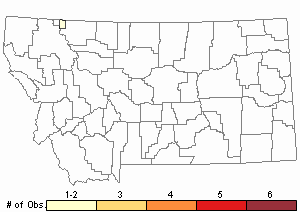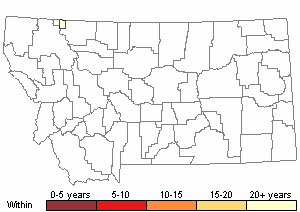View in other NatureServe Network Field Guides
NatureServe
Montana
Utah
Wyoming
Idaho
Wisconsin
British Columbia
South Carolina
Yukon
California
New York
A Liverwort - Porella platyphylla
Other Names:
Porella platyphylloides, Porella platyphylloidea
General Description
GROWTH FORM: Leafy.
PLANTS: Leafy liverworts that form flat mats when young, becoming thick tufts with age that protrude from trees and rocks. Strongly aromatic, but not acrid (Paton 1999). Shoots grow to 8 cm long, 1.8 to 2.7 mm wide, and are 2-3 times pinnate.
UPPER-LEAVES: Overlapping (imbricate) and dull green to yellowish-green. Dorsal leaves are semi-ovate, ovate, to orbicular, and toothed on the margin. Lobule (or ventral leaf) is a small lobe folded up on the underside of the dorsal leaf. Teeth point towards the leaf apex (antical) or are sometimes recurved. Lobules are narrowly ovate-triangular to lanceolate, spreading at 0 to 20 degrees from the stem, and from one- to two-thirds the width of the dorsal upper-leaves. Lobules are asymmetrical, sometimes auriculate at the base, and rarely with one tooth. Margins are deflexed to involute; inner margins are mostly sinuate-lobed, somewhat tapering toward the apex.
UNDER-LEAVES: Imbricate. Approximately, 1.5 to 2.5 times wider than the stem. Margins usually recurved, long-decurrent, sinuate-dentate, and occasionally with 1-2 cilia.
Sources: Conrad and Redfearn 1979; Hong 1983; Paton 1999; Schuster 1980; Vitt 1988; Finger Lakes Native Plant Society [FLNPS] 2020.
Diagnostic Characteristics
Porella platyphylla* Plants may catch your eye! Their dull yellow-green color and pinnate branching that protrudes also contrasts against dark tree trunks, rock, and snowy forest floors.
* All leaves overlap, including the under-leaves.
* The lobule margins are slightly revolute.
* Decurrent portion of under-leaves have smooth, slightly revolute margins.
* Plants turn violet with ‘iodine potassium-iodide’ or IKI.
Porella cordaeana * Size: Shoots are 3-4 mm wide.
* Lobules are about half the width of the under-leaves.
* Under-leaves do not overlap, leaving stretches of the stem visible.
* Decurrent portion of under-leaves are ruffled with a few teeth along the bases.
* Plants turn violet with IKI.
Porella navicularis * Size: Plants are glossy with shoots 1.5-3 mm wide.
* Trigones present - cell corners have the walls bulging inward.
* Lobules are neatly and noticeably revolute; nearly as wide as the under-leaves, and with an axis that diverges from the stem.
* Under-leaves are entire.
* Plants do not turn violet with IKI.
* Plants are strongly aromatic, but not acrid.
Porella roellii * Cells walls of the leaves without their corners bulging into the cell lumens.
* Under-leaves about twice as wide as the lobules.
* Lobules are oriented parallel to the main stem, and are much narrower than the under-leaves.
* Plants do not turn violet with IKI.
* Plants taste peppery when fresh (David. H. Wagner personal communication).
Sources: Piippo and Norris 1996; Paton 1999; Finger Lakes Native Plant Society [FLNPS] 2020.
Range Comments
In North America: Alaska, Arizona, British Columbia, Colorado, Idaho, Montana, New Mexico, Oregon, South Dakota, Washington, Wyoming, eastern US, and Canada (Patton 1999; Hong 1983). In Europe: Britain, Mediterranean islands, Morocco, Azores, Canaries, Faeroes, Iceland (Paton 1999). Also found in Asia (Paton 1999).
Observations in Montana Natural Heritage Program Database
Number of Observations: 2
(Click on the following maps and charts to see full sized version)
Map Help and Descriptions
Relative Density

Recency


 (Observations spanning multiple months or years are excluded from time charts)
(Observations spanning multiple months or years are excluded from time charts)
Habitat
On rocks and bark in moist, shaded sites (Hong 1976; Hermann 1969). The pinnately branched stems protrude from tree trunks, rocks, or the forest floor (FLNPS 2020).
Reproductive Characteristics
Dioicous (separate male and female plants).
Threats or Limiting Factors
Threats to Porella platyphylla populations include the loss of shade trees by forest fires, avalanches, and logging which can all degrade its habitat.
References
- Literature Cited AboveLegend:
 View Online Publication
View Online Publication Conrad, H.S. and P.L. Redfern. 1979. How to know the mosses and liverworts. Wm. C. Brown Co., Dubuque, Iowa. 302 pp.
Conrad, H.S. and P.L. Redfern. 1979. How to know the mosses and liverworts. Wm. C. Brown Co., Dubuque, Iowa. 302 pp. Finger Lakes Native Plant Society. 2008. A Glimpse of Green in the Snow. Obtained on December 16, 2020 at https://flnps.org/native-plants/glimpse-green-snow.
Finger Lakes Native Plant Society. 2008. A Glimpse of Green in the Snow. Obtained on December 16, 2020 at https://flnps.org/native-plants/glimpse-green-snow. Hermann, F. J. 1969. The bryophytes of Glacier National Park, Montana. The Bryologist 72:358-376.
Hermann, F. J. 1969. The bryophytes of Glacier National Park, Montana. The Bryologist 72:358-376. Hong, W.S. 1976. Annotated checklist of the hepatics of Idaho. The Bryologist 79:422-436.
Hong, W.S. 1976. Annotated checklist of the hepatics of Idaho. The Bryologist 79:422-436. Hong, W.S. 1983. The genus Porella in North America west of the Hundredth Meridian. The Bryologist 86:143 -155.
Hong, W.S. 1983. The genus Porella in North America west of the Hundredth Meridian. The Bryologist 86:143 -155. Paton, J.A. 1999. The Liverwort Flora of the Bristish Isles. Essex, England: Harley Books. 626 p.
Paton, J.A. 1999. The Liverwort Flora of the Bristish Isles. Essex, England: Harley Books. 626 p. Piippo, S. and D.H. Norris. 1996. A revision of Californian Porella. Ann. Bot Fennici 33:137-152.
Piippo, S. and D.H. Norris. 1996. A revision of Californian Porella. Ann. Bot Fennici 33:137-152. Schuster, Rudolf M. 1980. The Hepaticae and Anthocerotae of North America east of the hundredth meridian, volume IV. Columbia University Press. New York. 1334pp.
Schuster, Rudolf M. 1980. The Hepaticae and Anthocerotae of North America east of the hundredth meridian, volume IV. Columbia University Press. New York. 1334pp. Vitt, D.H., J.E. Marsh and R.B. Bovey. 1988. Mosses, Lichens and Ferns of Northwest North America. Lone Pine Publishing, Canada. 296 pp.
Vitt, D.H., J.E. Marsh and R.B. Bovey. 1988. Mosses, Lichens and Ferns of Northwest North America. Lone Pine Publishing, Canada. 296 pp.
- Additional ReferencesLegend:
 View Online Publication
View Online Publication
Do you know of a citation we're missing? Christy, J.A. and J. Harpel. 1995. Bryophytes of the Columbia River Basin south of the Canadian border. Report to the Interior Columbia Basin Ecosystem Management Project. Oregon Natural Heritage Program. 298 p.
Christy, J.A. and J. Harpel. 1995. Bryophytes of the Columbia River Basin south of the Canadian border. Report to the Interior Columbia Basin Ecosystem Management Project. Oregon Natural Heritage Program. 298 p. Christy, J.A. and J. Harpel. 1997. Rare bryophytes of the Interior Columbia River Basin and northern Great Basin, U. S. A. Journal of the Hattori Botanical Laboratory 82: 61-75.
Christy, J.A. and J. Harpel. 1997. Rare bryophytes of the Interior Columbia River Basin and northern Great Basin, U. S. A. Journal of the Hattori Botanical Laboratory 82: 61-75. Elliot, J. C. 1993. Second checklist of Montana mosses. Unpublished report. U.S. Forest Service, Region 1. Missoula, MT. 45 pp.
Elliot, J. C. 1993. Second checklist of Montana mosses. Unpublished report. U.S. Forest Service, Region 1. Missoula, MT. 45 pp. Hong, W. S. 1975. Leafy hepaticae of Montana and phytogeographic relationships to neighboring states and provinces. The Bryologist 78: 304-327.
Hong, W. S. 1975. Leafy hepaticae of Montana and phytogeographic relationships to neighboring states and provinces. The Bryologist 78: 304-327. Hong, W. S. 2002. 'A Key to the Hepaticae of Montana'. Northwest Science : Official Publication of the Northwest Scientific Association. 76: 271-285.
Hong, W. S. 2002. 'A Key to the Hepaticae of Montana'. Northwest Science : Official Publication of the Northwest Scientific Association. 76: 271-285. Hong, W.S. 1968. Hepaticae of the Lolo National Forest, Montana. The Bryologist 71: 362-365.
Hong, W.S. 1968. Hepaticae of the Lolo National Forest, Montana. The Bryologist 71: 362-365. Hong, W.S. 1968. The Hepaticae of Glacier National Park, Montana. The Bryologist 71:55-57.
Hong, W.S. 1968. The Hepaticae of Glacier National Park, Montana. The Bryologist 71:55-57. Moseley, R.K. and A. Pitner. 1996. Rare bryophytes and lichens in Idaho: Status of our knowledge. Boise, ID: Conservation Data Center, Idaho Department of Fish and Game. 50 p.
Moseley, R.K. and A. Pitner. 1996. Rare bryophytes and lichens in Idaho: Status of our knowledge. Boise, ID: Conservation Data Center, Idaho Department of Fish and Game. 50 p. Schofield, W.B. 1969. Phytogeography of Northwestern North America: Bryophytes and Vascular Plants. Madron 20(3):155-207.
Schofield, W.B. 1969. Phytogeography of Northwestern North America: Bryophytes and Vascular Plants. Madron 20(3):155-207. Stotler, R. and B. Crandall-Stotler. 1977. A checklist of liverworts and hornworts of North America. The Bryologist. 76:405-428.
Stotler, R. and B. Crandall-Stotler. 1977. A checklist of liverworts and hornworts of North America. The Bryologist. 76:405-428. Thierren, J.P., B.J. Crandall-Stotler, and R.E. Stotler. 1998. Morphological and genetic variation in Porella platyphylla and Porella platyphylloidea and their systematic implications. The Bryologist 101:1-19.
Thierren, J.P., B.J. Crandall-Stotler, and R.E. Stotler. 1998. Morphological and genetic variation in Porella platyphylla and Porella platyphylloidea and their systematic implications. The Bryologist 101:1-19.
- Web Search Engines for Articles on "A Liverwort"





